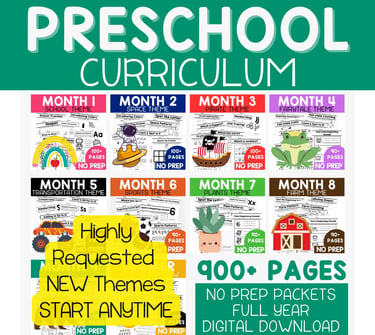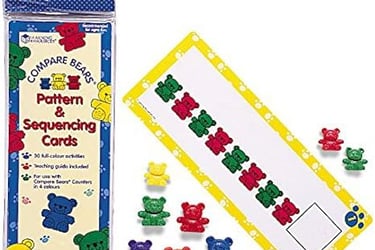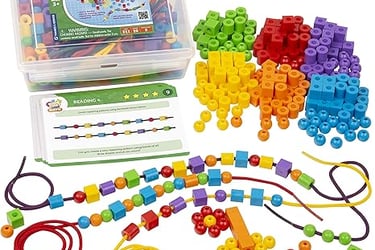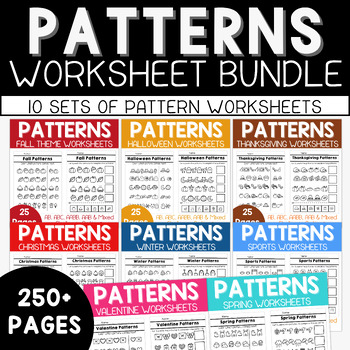Pattern Recognition: A Secret Superpower For Your Little One!
Why do we need an emphasis on pattern recognition in early childhood education?
AB
6/11/20255 min read

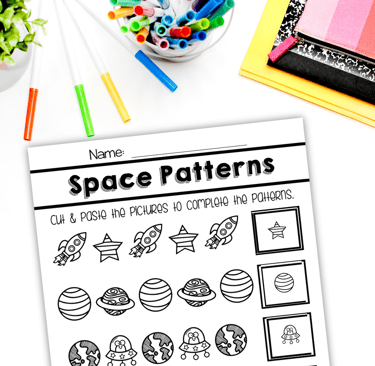
Have you ever wondered why so many early childhood resources have an emphasis on pattern recognition?
You see- our whole world is full of patterns. And recognizing them is a key building block to everything. Kids need this skill to academically succeed in just about every area.
What Is Pattern Recognition, Anyway?
It sounds fancy, but it’s just your little one spotting and making sense of repeating sequences. Think of it like noticing the colors in a bead necklace (red, blue, red, blue) or catching the beat in their favorite song. It’s the kind of thing their brains are already doing without us even realizing it!
Preschoolers are practically hardwired for this. Their curious little minds love predictability. Did you ever notice how they beg for the same bedtime story night after night? That’s because their brains thrive on spotting those familiar patterns. It’s like their way of making sense of the big, wide world.
Why Pattern Recognition Is an Early Childhood Superpower
Let's talk about why pattern recognition is like a secret superpower for our little ones. Early childhood researchers, like those at the National Association for the Education of Young Children (NAEYC), say this skill builds brain connections that help kids organize information, like a mental filing cabinet! When your preschooler notices that their blocks go “big, small, big, small,” their brain is creating pathways to sort and store info, making learning easier down the road.
It also boosts problem-solving in a big way. Spotting patterns teaches kids to predict what comes next, which is huge for puzzles, math, and even navigating tricky social moments. Dr. Alison Gopnik, a renowned child development expert, points out that pattern recognition helps kids “anticipate and adapt,” whether they’re figuring out a shape sorter or guessing how a friend might react in a social setting. It’s like giving them a mental toolbox for life’s challenges!
Plus, patterns spark curiosity. Kids who notice patterns start asking why (why does the sun rise every morning? Why do trees lose their leaves in autumn?) Researchers like Dr. Susan Gelman note that this questioning fuels a love for learning that sticks with them. And let me tell you, from one mom to another: I saw my daughter nail the “clap, stomp, clap” rhythm in music class, and now she’s the first to solve puzzles at home. That proud-mom moment when you see your kid light up? That’s pattern recognition working its magic!
How It Connects to Later Learning
Let’s talk about how pattern recognition sets our kiddos up for big wins later on. First, it’s math magic! Patterns are the building blocks of numbers, shapes, and even algebra. When your preschooler sorts their toys by size or color, they’re laying the foundation for understanding sequences and equations. Researchers like Dr. Douglas Clements, an early math expert, say pattern recognition is “critical for mathematical thinking,” helping kids grasp concepts like counting and geometry before they even hit kindergarten.
Then there’s reading readiness. Recognizing patterns in letters like spotting “c-a-t” or rhyming words in a storybook helps kids sound out words and make sense of stories. The National Reading Panel backs this up, noting that pattern recognition strengthens phonemic awareness, a key step in learning to read. It’s like giving them a head start on cracking the code of words!
Pattern recognition also shines in science and critical thinking. When kids notice patterns in nature, like how leaves grow in pairs or how the weather changes, they start making predictions and testing ideas. This is the heart of the scientific method! Early childhood studies, like those from the National Science Teachers Association, show that pattern-based thinking helps kids approach problems with curiosity and logic.
And let’s not forget real-world skills. From budgeting (tracking spending patterns) to coding (spotting sequences in code), pattern recognition is everywhere in adulthood. It’s the skill that helps us navigate life’s complexities. As a mom, I want my kiddo to tackle challenges with confidence, and this skill is like a secret weapon for life. Watching her figure out patterns now makes me so excited for the bright future she’s building!
Easy Ways to Teach Pattern Recognition (Even for Busy Moms)
I know our days are packed with diaper changes, snack prep, and trying to sneak in a sip of coffee while it’s still warm. But teaching pattern recognition? It’s so easy to weave into your routine, and it’s fun for both you and your little one! Here’s how to make it work without adding stress to your busy life.
Fit it into daily life: You don’t need a lesson plan to teach patterns-just point them out during your day!
While getting dressed, say, “Look, your PJs have blue, red, blue, red!”
At mealtime, notice patterns in food, like alternating apple and banana slices on a plate.
Even bedtime routines can be a game-maybe it’s “book, song, hug, book, song, hug.”
These little moments help your kiddo spot patterns naturally, and it’s already part of what you’re doing!
Quick games: Turn everyday moments into pattern play with zero prep.
Try clapping rhythms together, like “clap, stomp, clap,” and let your preschooler copy or add to it.
While folding laundry (because, let’s be real, there’s always laundry), have them sort socks by color or size-red, blue, red, blue.
At snack time, make fruit skewer patterns (strawberry, grape, strawberry, grape) or cereal patterns.
These quick games are fun and build their brain power while you’re tackling your to-do list.
Toys that help: You don’t need fancy supplies-your house is full of pattern-making tools! If you do want some toys that make it easier to practice, these are our favorites:
Bear Counter Patterns
Lacing Bead Patterns
Math Link Cubes
Direct Instruction & Printables Make It Even Better
I always start teaching patterns with this video. We LOVE simple garden videos in our family for all kinds of skills and topics but this one is by far our favorite-”REPEAT!” (Watch the video and you will understand 😉)
Next I like to start with hands on activities as described in this blog. Use toys or food and create patterns and ask your child to add on to it.
Lastly, put it into action with printables- there are many out there but I offer two options that will help you get started.
My full year preschool curriculum is FULL of pattern recognition practice. Each month you will get 2-4 printables that relate to the theme of that month.
My patterns bundle includes 10 fun themes and over 250 pages of pattern practice.
Whatever you do to teach your child pattern recognition-make sure you do because it really is so important!
Happy Learning!
Sources:
National Association for the Education of Young Children (NAEYC): Advances in Understanding Child Development and Learning Through a Lens of Equity
Dr. Alison Gopnik: Alison Gopnik on Young Children’s Intelligence and the Role of Play
Dr. Susan Gelman: Math and Science in Preschool
Dr. Douglas Clements: Learning and Teaching Early Math: The Learning Trajectories Approach
National Reading Panel: Findings of the National Reading Panel
National Science Teachers Association (NSTA): Framework for K–12 Science Education
Affiliate Links included-creator earns commission on amazon links
